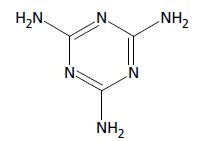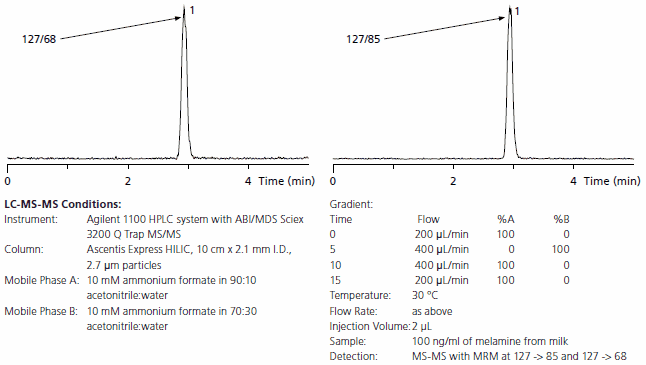Analysis of Melamine in Milk
Olga Shimelis, Carmen T. Santasania
AnalytiX Volume 9 Article 1
Section Overview
Introduction
Recent news stories from China1 have reported incidents of milk, milk products, and infant formula tainted with melamine, a substance used to make plastics and fertilizers. It is not approved for use in foods, but health officials reported melamine was added to these dairy products to inflate their apparent protein content. Several infants died and thousands of children were hospitalized after suffering kidney failure from ingesting the melamine-adulterated milk. Laboratories worldwide are now developing methods to test products for melamine.
Milk is a complex sample matrix, demanding careful sample prep to ensure valid melamine-content results. We offer high-purity melamine and cyanuric acid chemicals, which allow customers to prepare their own standards to meet their particular application needs; as well as Discovery® solid phase extraction products to ensure clean samples, and Ascentis® HILIC columns to give superior chromatographic results.
Discussion
Sample extraction
A 5 mL aliquot of milk was spiked with melamine standard (52549). Next, 5 mL of phosphate buffer (100mM, pH 2.5) and 1 mL acetonitrile were added to the sample and set in an ultrasonic bath for 5 minutes. The sample was centrifuged at 3500 rpm for 10 minutes and the middle supernatant separated from the top and the bottom layers.
Sample SPE preparation
Supelco® Discovery DSC-SCX 500 mg/6 mL SPE tubes (52688-U) were used for further sample cleanup. The SPE tubes were conditioned with 3 mL methanol and 3 mL 100mM phosphate buffer (pH 2.5). Then 2.2 mL of the resulting supernatant was loaded into the SPE tube and washed with 3 mL of phosphate buffer (100mM, pH 3) and 3 mL of methanol. The melamine was eluted with 4 mL 5% ammonia in methanol. The elution solvent was evaporated to dryness at 50 °C in a water bath under a flow of nitrogen at 5 psi. The samples were reconstituted into 1 mL of the LC mobile phase A (see conditions below).
LC-MS-MS method
Melamine (Figure 1) is a polar molecule with a pKa of 5.6 and a Log P value of -1.37,2 making it a good candidate for aqueous normal phase (ANP) chromatography. In ANP, a polar hydrophilic analyte partitions between a relatively polar stationary phase and a relatively non-polar mobile phase. ANP is commonly referred to as HILIC, but the term HILIC (Hydrophilic Interaction Chromatography) implies a mechanism that is one of several that may be operative under ANP conditions. Determining melamine content using the HILIC mode, run on Supelco’s Ascentis Express HILIC column (53939-U), gives better retention of the polar molecule than conventional reversed-phase chromatography.

Figure 1. Structure of Melamine
This HILIC mechanism describes the process of preferential solvation of the polar stationary phase with the aqueous component of the mobile phase, and subsequent depletion of the mobile phase of water. This sets up a biphasic system where there is a semi-immobilized layer of water near the surface and an organic-rich mobile phase layer. A polar compound may then partition from the moving organic-rich mobile phase into the stagnant aqueous solvent near the surface. Water then becomes the “strong” solvent and analytes generally elute (assuming HILIC is the dominant mechanism) in order of “decreasing” hydrophobicity (a lower log P, indicating a more polar molecule, and consequently more retention).
Detection for melamine was accomplished using an ABI/MDS SCIEX® 3200 QTRAP® MS/MS with the parameters below. Two multiple reaction monitoring (MRM) transitions were monitored; 127/85 MRM was used for quantitation.
Other instrument parameters were as follows:
Curtain Gas: 20
Ion Spray Voltage: 5000
Gas 1: 20
Temperature: 350 °C
Gas 2: 40
Quantitation
An external calibration curve was used for melamine. External calibration standards were prepared in the mobile phase. No matrix-matched standards were used.
Because melamine is often present together with cyanuric acid and the two form a very stable complex, we also tested the melamine from milk in the presence of cyanuric acid. Both melamine and cyanuric acid were mixed at 1000 ng/mL in water and the samples kept for 30 minutes. Then the milk was spiked at 100 ng/mL of the mixture, and the subsequent analysis yielded a 94% melamine recovery rate.
We also examined the ionization effect of the cleaned sample by spiking melamine into a cleaned blank milk sample, followed by analysis with LC-MS-MS. This test can be an indicator of the effectiveness of sample cleanup; the cleaned sample should have no effect on the ionization of the analyte of interest. The spiked concentration was 100 ng/mL, and the found concentration was 105 ng/mL, indicating no ionization effects from the cleaned sample.

Figure 2. LC-MS-MS Analysis of Melamine Extracted from Milk Spiked at 100 ng/mL
Conclusion
Using Supelco Discovery DSC-SCX SPE cartridges, a sample preparation method for the extraction of melamine from milk was developed. Good recoveries were seen for the melamine at concentrations between 10 ng/mL and 500 ng/mL. Standards developed with our high-purity melamine and cyanuric acid chemicals ensure valid results. Finally, HILIC with the Ascentis Express HILIC HPLC column gave good retention of the analyte. A further advantage of the HILIC mode is the enhanced MS response due to the high concentration of organic in the mobile phase.
References
- QTRAP is a registered trademark of AB Sciex Pte. Ltd., Applied Biosystems/MDS Analytical Technologies, a joint venture between Applied Biosystems and MDS Inc.
- MDS and SCIEX are registered trademarks of MDS Inc.
To continue reading please sign in or create an account.
Don't Have An Account?